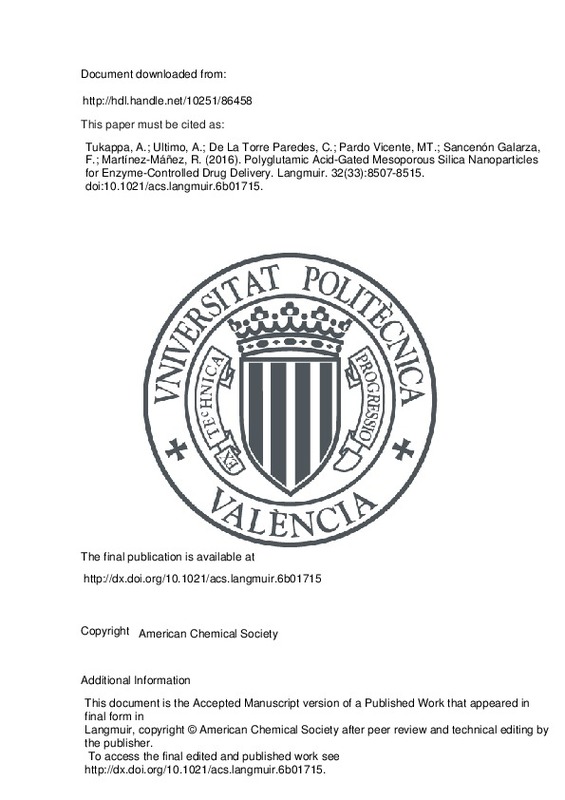Tukappa, A.; Ultimo, A.; De La Torre Paredes, C.; Pardo Vicente, MT.; Sancenón Galarza, F.; Martínez-Máñez, R. (2016). Polyglutamic Acid-Gated Mesoporous Silica Nanoparticles for Enzyme-Controlled Drug Delivery. Langmuir. 32(33):8507-8515. https://doi.org/10.1021/acs.langmuir.6b01715
Por favor, use este identificador para citar o enlazar este ítem: http://hdl.handle.net/10251/86458
|
Título:
|
Polyglutamic Acid-Gated Mesoporous Silica Nanoparticles for Enzyme-Controlled Drug Delivery
|
|
Autor:
|
Tukappa, Asha
Ultimo, Amelia
De la Torre Paredes, Cristina
 Pardo Vicente, María Teresa
Pardo Vicente, María Teresa

 Sancenón Galarza, Félix
Sancenón Galarza, Félix

 Martínez-Máñez, Ramón
Martínez-Máñez, Ramón
|
|
Entidad UPV:
|
Universitat Politècnica de València. Departamento de Química - Departament de Química
|
|
Fecha difusión:
|
|
|
Resumen:
|
Mesoporous silica nanoparticles (MSNs) are highly
attractive as supports in the design of controlled delivery systems
that can act as containers for the encapsulation of therapeutic agents,
overcoming common issues such ...[+]
Mesoporous silica nanoparticles (MSNs) are highly
attractive as supports in the design of controlled delivery systems
that can act as containers for the encapsulation of therapeutic agents,
overcoming common issues such as poor water solubility and poor
stability of some drugs and also enhancing their bioavailability. In
this context, we describe herein the development of polyglutamic
acid (PGA)-capped MSNs that can selectively deliver rhodamine B
and doxorubicin. PGA-capped MSNs remain closed in an aqueous
environment, yet they are able to deliver the cargo in the presence of
pronase because of the hydrolysis of the peptide bonds in PGA. The
prepared solids released less than 20% of the cargo in 1 day in water,
whereas they were able to reach 90% of the maximum release of the
entrapped guest in ca. 5 h in the presence of pronase. Studies of the
PGA-capped nanoparticles with SK-BR-3 breast cancer cells were
also undertaken. Rhodamine-loaded nanoparticles were not toxic, whereas doxorubicin-loaded nanoparticles were able to
efficiently kill more than 90% of the cancer cells at a concentration of 100 μg/mL.
[-]
|
|
Palabras clave:
|
Operated mechanized nanoparticles
,
Metastatic breast-cancer
,
Controlled-release
,
Guest molecules
,
Targeted delivery
,
Soluble drugs
,
DNA
,
Systems
,
Nanomedicine
,
Supports
,
Electron Microscopy Service of the UPV
|
|
Derechos de uso:
|
Reserva de todos los derechos
|
|
Fuente:
|
Langmuir. (issn:
0743-7463
)
|
|
DOI:
|
10.1021/acs.langmuir.6b01715
|
|
Editorial:
|
American Chemical Society
|
|
Versión del editor:
|
http://dx.doi.org/10.1021/acs.langmuir.6b01715
|
|
Código del Proyecto:
|
info:eu-repo/grantAgreement/MINECO//MAT2015-64139-C4-1-R/ES/NANOMATERIALES INTELIGENTES, SONDAS Y DISPOSITIVOS PARA EL DESARROLLO INTEGRADO DE NUEVAS HERRAMIENTAS APLICADAS AL CAMPO BIOMEDICO/
info:eu-repo/grantAgreement/GVA//PROMETEOII%2F2014%2F047/ES/Nuevas aproximaciones para el diseño de materiales de liberación controlada y la detección de compuestos peligrosos/
|
|
Descripción:
|
This document is the Accepted Manuscript version of a Published Work that appeared in final form in
Langmuir, copyright © American Chemical Society after peer review and technical editing by the publisher.
To access the final edited and published work see http://dx.doi.org/10.1021/acs.langmuir.6b01715.
|
|
Agradecimientos:
|
A.T. wishes to express her gratitude to the Erasmus mundus (Svagata.eu) financial support. A.U. and C. de la T. are grateful to the Spanish Ministry of Education, Culture and Sport for her doctoral fellowship. We thank the ...[+]
A.T. wishes to express her gratitude to the Erasmus mundus (Svagata.eu) financial support. A.U. and C. de la T. are grateful to the Spanish Ministry of Education, Culture and Sport for her doctoral fellowship. We thank the Spanish Government (Project MAT2015-64139-C4-1-R, MINECO/FEDER) and Generalitat Valenciana (Project PROMETEOII/2014/047) for their support. The authors also thank UPV electron microscopy services for the technical support.
[-]
|
|
Tipo:
|
Artículo
|







![[Cerrado]](/themes/UPV/images/candado.png)


